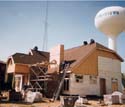Roof assemblies play important roles in buildings' overall abilities to resist fires. For this reason, building codes generally require buildings' roof assemblies to meet specific fire-resistance characteristics. Roof assemblies typically are required to resist the spread of fires originating from buildings' exteriors and interiors. The specific degree of fire resistance required primarily is based on a building's construction, occupancy and location.
Exterior exposure
Roof assemblies' abilities to resist fires originating on buildings' exteriors are determined by subjecting representative small-scale specimens of roof assemblies to laboratory testing using one of several recognized standard test methods: ASTM E108, "Standard Test Methods for Fire Tests of Roof Coverings"; UL 790, "Standard for Tests for Fire Resistance of Roof Covering Materials"; or FM 4470, "Approval for Class I Roof Covers." These test methods provide the basis for Class A, Class B and Class C fire ratings.
Class A-rated roof assemblies are effective against severe fire test exposure. A Class A fire rating is the most stringent rating available for exterior fire resistance. Class B-rated roof assemblies are effective against moderate fire test exposure. And Class C-rated roof assemblies are effective against light fire test exposure. A Class C fire rating is the least stringent rating available for exterior fire resistance. If a roof assembly cannot pass the Class C criteria, it typically is considered to be nonclassified.
Certain roof assembly types are exempt from fire testing based on their inherent ability to resist fires originating on a building's exterior. For example, inthe 2003 International Building Code (IBC), brick, masonry, slate, clay or concrete tile, exposed concrete, ferrous or copper shingles or sheet roof assemblies are recognized as being Class A-rated without being tested. Similarly, IBC recognizes other metal (aluminum) sheet or shingle roof assemblies as being Class B-rated without testing.
Because the specific exterior fire rating required for a building largely is based on a building's construction classification, IBC's Table 1505.1 provides a listing of the minimum exterior fire ratings required for specific construction types. Construction types are determined in IBC using Chapter 6—Type of Construction.
It is important to realize Class A-rated roof assemblies are required for few buildings. According to IBC, a Class A-rated roof assembly only may be necessary if it is part of interior fire-rating requirements, a building is located in a specific fire district, or the Urban-Wildland Interface Code also applies and specifically requires a Class A-rated construction.
Interior exposure
Roof assemblies' abilities to resist fires originating in buildings' interiors also are determined by subjecting representative small-scale specimens of roof assemblies to one of several laboratory tests. These tests are FM 4450, "Test Standard for Class I Insulated Steel Deck Roofs"; FM 4470; and UL 1256, "Standard for Fire Test of Roof Deck Constructions."
FM 4450 and FM 4470 provide the technical basis for Class I ratings, such as FM Global's I-60, I-90, I-120, etc., approval ratings. UL 1256 provides the technical basis for one-hour, one-and-a-half-hour, two-hour, etc., interior-fire ratings.
The specific interior-fire rating required for a building is determined by occupancy and type of construction. For example, using IBC, it is necessary to consider Chapter 3—Use and Occupancy Classification, Chapter 6—Type of Construction and Chapter 7—Fire-resistance-rated Construction to determine interior-fire classifications.
Learn the basics
I encourage you to become familiar with buildings' exterior and interior fire-rating requirements. In many instances, compliance with such requirements meets specific provisions in building codes. I also encourage roof system designers to closely consider buildings' fire-rating requirements. Any specific exterior or interior fire-rating requirements for roof assemblies should be specified clearly.
Detailed information regarding specific roof assemblies' exterior and interior fire-resistance ratings are provided in FM's Approval Guide and UL's Building Materials Directory and Fire Resistance-rated Construction Directory. UL's directory information also is available online at www.ul.com.
Mark S. Graham is NRCA's associate executive director of technical services.

